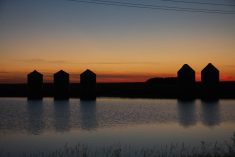SKOOKUMCHUCK, B.C. — There are enclosures, so it stands to reason there are also exclosures.
And it’s exclosures that are the focus of range management studies in southeastern British Columbia.
These small fenced areas have kept out elk, deer and cattle since 1951, allowing nature to take its course with vegetative growth.
One exclosure on a piece of land ranched by Barry Minor includes grass species and tree growth that are absent on the rest of the semi-bald pasture.
Read Also

Know what costs are involved in keeping crops in the bin
When you’re looking at full bins and rising calf prices, the human reflex is to hold on and hope for more. That’s not a plan. It’s a bet. Storage has a price tag.
“What this exclosure demonstrates is how resilient these ecosystems are, so with proper management they will return to their ecological potential,” said agronomist Tim Ross, who has studied range management in the region for the last 20 years.
“It’s demonstrating that in the way these ranges are and have been overstocked, by cattle and wild ungulates, and also this goes back to the 1930s because there were thousands of wild horses in this country, too.”
More recently, competing activities and interests have made it difficult to ranch in this region of B.C. Large elk and deer herds, forestry activity and traffic related to golf courses and hot springs expose it to major pressures.
Those involved in recreation, wildlife protection and forestry operations can all be at odds with ranching interests, depending on the situation.
Add that to a falling water table in this region and ranchers have major challenges with grazing management and carrying capacity.
Minor said cattle weight gains of one to two pounds per day are the best he can achieve given the 300 elk and 100 white-tailed deer that traverse his property daily.
Wildlife fencing helped the situation in one of his pastures and he also allows hunting on his property, although that brings its own problems.
“I like 98 percent of the hunters. It’s the other two percent I don’t care for,” Minor told a delegation from the Society for Range Management.
Theft of solar panels used for stock watering and fences left open by hunters have caused problems. So have all-terrain vehicles and dirt bike riders who chase his cattle.
Forest encroachment, which used to be handled by burning, has reduced grazing, he added, and forestry operations aren’t an adequate solution.
This region of B.C. can be extremely dry, and Minor has fed wild elk in previous years to keep them from starving.
“It sure came back to bite me in the butt, but I still feel good in my heart about it,” he said.
Cattle numbers in the area peaked in the 1960s, then dropped and have been relatively stable since, said Ross.
In the meantime, elk numbers have increased by more than 150 percent and range conditions have deteriorated as a result.
He believes elk are aware of hunting season and have adapted to the pressure by grazing at night and even bugling less often.
They’ve become accustomed to grazing in ranchers’ pastures and hay fields.
However, Ross said other exclosure studies that allow limited access by cattle and elk show promise. Grass growth improves when access is well managed.
Ross shares some of Minor’s frustration with competing interests of government departments and groups.
“Ultimately we have sectors being managed separately instead of managing the ecosystem as a whole,” said Ross.
“My favourite analogy is, if this was your Skookumchuk Land Timber Wildlife Company, would you have your divisions squabbling? As CEO, you’d say no, get it together or you guys are all gone.”
He thinks a focus on broader goals of functional grassland and forest management is needed.
“It’s an evolving and interesting story down here. And I don’t want to sound like I’m blaming anybody at all. It is what it is. It’s complicated and it’s challenging.”
GRAZING RECOMMENDATIONS
The East Kootenay Trench Agriculture/ Wildlife Committee, formed in 1990, has made recommendations on how to improve grazing in southeastern British Columbia and reduce conflicts between ranchers and those with wildlife conservation interests:
• Modified cattle herd sizes, shorter grazing periods, improved distribution of water and salt
• Cattle stocking rates that are relative to seasonal availability of forage
• Wildlife management that balances numbers and ensures wildlife don’t negate gains from better livestock management
• Livestock turnout dates in key wildlife winter ranges that allow a rest period for forage plants
• Monitoring ecosystem restoration and range health
• Emphasis on reducing forest cover on traditional grassland and maintaining open forest sites















